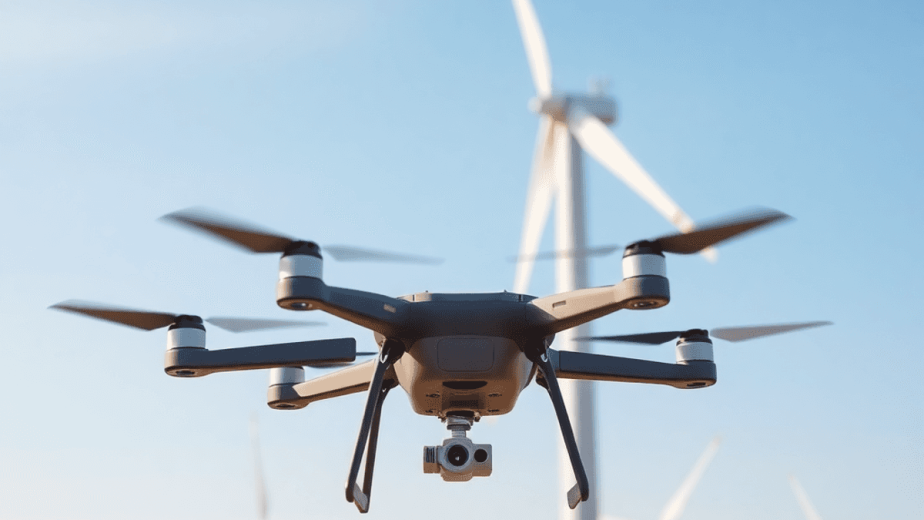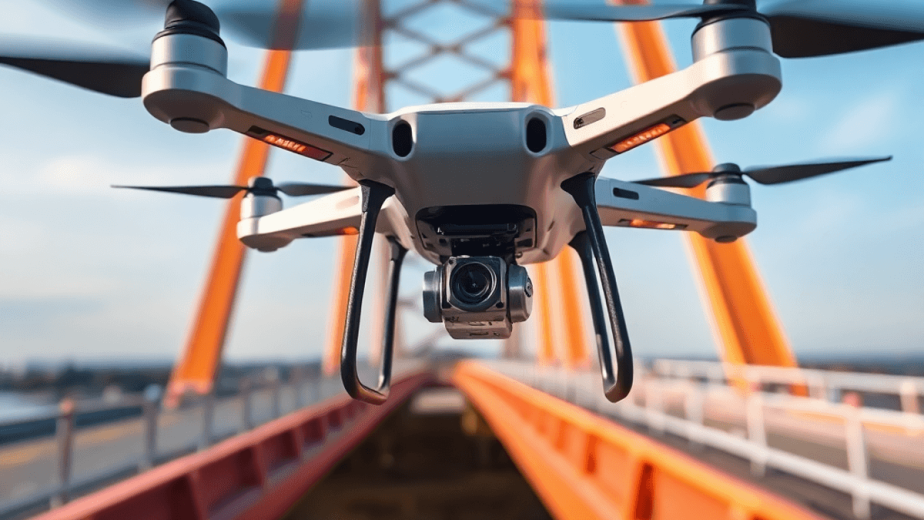Introduction
The use of drones for inspecting solar panels has grown significantly. This new technology is changing the way we evaluate rooftop solar systems, providing many benefits compared to traditional inspection methods.
Key benefits include:
- Enhanced efficiency: Drones significantly reduce inspection times.
- Cost savings: Lower labor and operational costs for solar companies.
- Improved safety: Reduced risks associated with manual inspections.
With companies like Mira Spatial at the forefront of using drones for infrastructure monitoring, the world of solar inspections is changing. Their commitment to incorporating advanced technology guarantees thorough data gathering and analysis. As the need for renewable energy rises, adopting drone inspections can improve asset management and boost performance in the solar sector. The move towards using drones for evaluations promises to make processes smoother while ensuring precision and safety.
1. The Rise of Drone Technology in Solar Inspections
The evolution of drone technology in the energy sector marks a significant shift in how solar panel assessments are conducted. Drones have transitioned from niche applications to vital tools for efficiency and accuracy.
Key Benefits of Drones in Inspections
- Speed: Drones can cover large areas quickly, reducing the time spent on inspections.
- Precision: Advanced imaging technologies enable high-resolution capture of solar panels, allowing for detailed analysis.
- Accessibility: Drones can reach difficult locations without the need for scaffolding or ladders, minimizing risks associated with manual inspections.
The integration of AI and advanced imaging has further enhanced drone capabilities. AI algorithms analyze data collected by drones, identifying potential issues such as faulty modules or string outages with remarkable accuracy. These innovations not only streamline inspections but also empower companies to make informed decisions based on comprehensive data.
As the demand for renewable energy solutions grows, so does the necessity for effective monitoring techniques. Embracing drone technology allows solar installation companies to stay ahead of the curve, ensuring both operational efficiency and superior service delivery.
2. Efficiency in Solar Panel Assessments with Drones
Using drones for solar panel assessments greatly improves efficiency, saving a significant amount of time during inspections. A comparison shows that drone inspections can be done much faster than traditional methods.
1. Inspection Times
- Drone inspections typically take 30-60% less time than manual inspections utilizing handheld devices.
- Drones can conduct thorough assessments of large solar arrays in mere minutes, while traditional methods may require hours.
2. Case Study
Consider a scenario where a team uses a handheld thermal device for inspections. This method may take two hours for a medium-sized installation. In contrast, deploying a drone equipped with thermal imaging technology completes the same inspection in 20-30 minutes.
The impact on operational productivity is profound. Rapid assessments allow teams to allocate resources more effectively, reducing downtime and speeding up project timelines. This efficiency not only streamlines workflows but also enables quicker identification of issues, ensuring optimal performance of solar installations.
Embracing drone technology boosts your inspection capabilities, ultimately leading to improved overall productivity in solar panel assessments.
3. Cost Reduction Through Drone Inspections
The integration of drone technology in solar inspections brings significant cost reduction opportunities. Key areas of savings include:
- Labor Savings: Traditional inspection methods often require large teams and extensive man-hours. Drones streamline this process, reducing the need for personnel on-site, which leads to substantial labor cost savings.
- Time Efficiency: Drones can complete inspections in a fraction of the time compared to manual methods. This rapid assessment translates into lower operational costs and allows teams to focus on more critical tasks.
Long-term financial benefits for solar installation companies are evident through:
- Lower Maintenance Costs: With drones providing regular monitoring, potential issues can be detected early, preventing costly repairs and downtime.
- Enhanced Project Budgets: The decreased expenditure on labor and improved efficiency contribute positively to overall project budgets, making solar installations more economically viable.
The return on investment (ROI) from drone inspections is compelling. By minimizing labor costs and maximizing efficiency, companies position themselves to achieve greater profits while maintaining high-quality standards. Embracing drone technology not only elevates inspection processes but also enhances the economic landscape of solar projects.
4. Enhancing Safety with Drone Technology in Solar Inspections
The use of drones in solar inspections significantly enhances safety. Traditional inspection methods often involve manual processes that expose workers to various risks, particularly when using ladders or scaffolding. These practices can lead to accidents, injuries, and potential liabilities.
Drones provide a safer alternative by eliminating the need for personnel to ascend to high-risk areas. With aerial capabilities, drones can conduct inspections without the physical presence of workers in dangerous locations. This risk reduction not only protects employees but also ensures compliance with safety regulations.
Key Safety Improvements:
- Elimination of Climbing: Drones inspect rooftops and hard-to-reach areas without requiring workers to climb.
- Reduced Physical Strain: Workers avoid the physical demands and hazards associated with manual inspections.
- Real-Time Monitoring: Drones can survey large installations quickly, reducing the time spent in potentially hazardous environments.
Real-World Examples:
- A solar installation company reported a 40% decrease in safety incidents after adopting drone inspections.
- Another case involved a utility provider that utilized drones for transmission line assessments, resulting in zero worker injuries during aerial surveys.
Embracing drone technology not only streamlines inspections but fundamentally transforms safety protocols within the solar industry.
5. Comprehensive Data Collection Capabilities of Drones for Solar Installations
Drones equipped with advanced technology enhance data collection in solar installations significantly. Their capabilities include:
1. Issue Detection
Drones can identify various problems, such as:
- Faulty Modules: Thermal imaging detects temperature discrepancies that indicate malfunctioning solar panels.
- String Outages: Drones can assess the performance of solar strings, pinpointing failures quickly.
2. High-Resolution Imaging
The ability to capture high-resolution images from multiple angles provides detailed insights into the condition of solar installations. This comprehensive view aids in identifying subtle issues that may be overlooked during manual inspections.
3. Data Sharing and Collaboration
Drones facilitate seamless sharing of collected data across teams. This capability enhances collaboration and allows stakeholders to access real-time information about the installation’s status. Advanced platforms enable visualization of the data, making it easier for teams to analyze and discuss findings effectively.
Moreover, the extensive data collection capabilities of drones are not just limited to visual inspections or thermal imaging. They also encompass a wide range of other data collection methods that can significantly benefit solar installations. For instance, drones can gather comprehensive datasets related to geographical features, weather patterns, and more, which are crucial for optimizing solar energy production.
Investing in drone technology for data collection not only streamlines the inspection process but also ensures that any potential issues are addressed swiftly, preserving the efficiency and longevity of solar installations.
6. Detailed Reporting and Analysis with Drone Data in Solar Inspections
Detailed reports generated from drone inspections serve as crucial tools for stakeholders, including clients and project teams. These reports provide comprehensive insights into the condition of solar installations, enabling informed decision-making regarding maintenance and operational efficiency.
Key aspects include:
-
Interactive Maps: Drones create high-resolution, interactive maps that visualize the solar installation’s layout and condition. This feature allows stakeholders to easily identify areas needing attention and track changes over time.
-
System Condition Overview: Reports deliver a clear overview of system performance, highlighting issues such as faulty modules or string outages. This information is vital for maintaining optimal energy production and ensuring long-term reliability.
-
Use Cases for Warranty Claims Validation: The detailed data collected can support warranty claims validation by providing concrete evidence of system performance and potential failures. This strengthens communication with manufacturers and enhances the likelihood of successful claims.
The integration of advanced reporting tools transforms how solar inspections are approached, allowing for greater transparency, collaboration, and efficiency in managing rooftop solar installations.
7. Versatility Across Different Types of Solar Installations: Residential vs Commercial Assessments using Drones
The versatility of drone technology enhances its applicability across diverse solar setups, including residential and commercial installations. This adaptability allows for tailored inspection processes suited to specific requirements.
1. Residential Installations
Drones can assess rooftops efficiently, capturing high-resolution images to identify issues such as shading or module damage. Quick assessments help homeowners maintain system performance without extensive physical labor.
2. Commercial Installations
Larger solar farms benefit from drones that can cover vast areas rapidly. Customization options exist for different installation sizes, enabling comprehensive inspections regardless of complexity. High-resolution imaging from multiple angles reveals detailed insights into system health.
This capability streamlines inspections while ensuring accuracy, positioning drones as an essential tool for both residential and commercial solar assessments. The flexibility to adapt to various installation types underlines the role of drone technology in transforming solar energy management.
The Future Potential Of Drone Inspections For Rooftop Solar Installations
The world of rooftop solar inspections is about to change significantly with future advancements in technology.
1. AI Enhancements
The integration of artificial intelligence is set to revolutionize the accuracy and efficiency of drone inspections. AI can analyze vast amounts of data collected by drones, identifying patterns and anomalies that may go unnoticed by human inspectors.
2. Enhanced Imaging Technologies
Future drones may incorporate cutting-edge imaging technologies, improving resolution and depth perception. This allows for more detailed assessments of solar panels, facilitating early detection of potential failures.
3. Autonomous Operations
Advances in autonomy will enable drones to conduct inspections without human intervention. This reduces labor costs and increases inspection frequency, enhancing maintenance schedules.
4. Real-Time Data Analytics
Future drone systems could offer real-time analytics, providing stakeholders with immediate insights into solar panel conditions, thus streamlining decision-making processes.
These innovations promise to elevate the effectiveness and reliability of rooftop solar installation inspections, paving the way for a more sustainable energy future.
Conclusion: Embracing Drone Technology for Efficient, Cost-Effective, and Safe Solar Installation Assessments
The benefits of inspecting rooftop solar installations with drones are clear:
- Efficiency in assessment times
- Cost reduction through decreased labor and time expenses
- Enhanced safety for workers
- Comprehensive data collection capabilities
- Detailed reporting and analysis
These advantages highlight the transformative role of drone technology in solar inspections. Consider integrating drones into your solar installation assessments. By adopting this innovative approach, you can enhance operational efficiency, ensure safety, and optimize project budgets. Embrace the future of solar inspections today.



